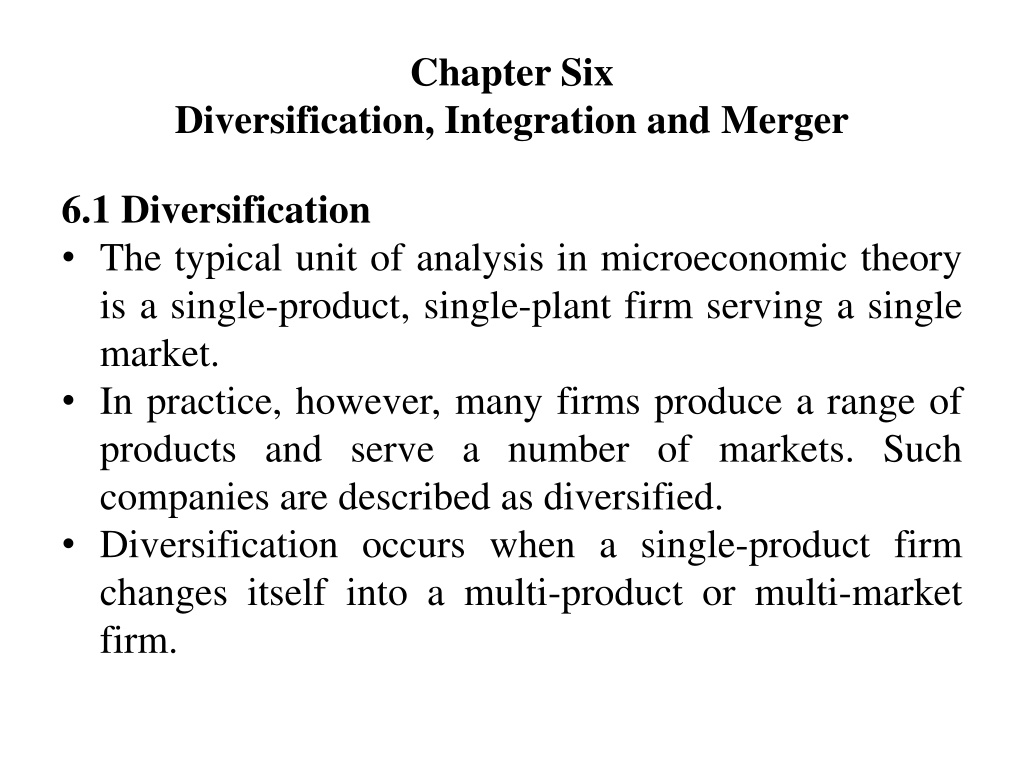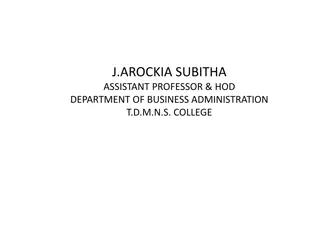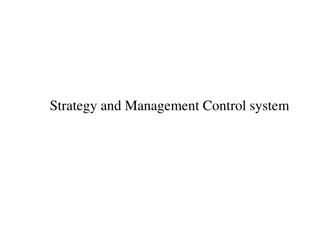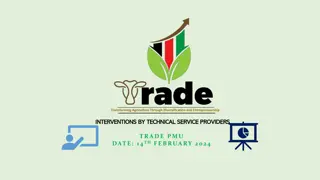Understanding Diversification Strategies in Business
Diversification in business involves expanding a firm's range of products or markets, leading to various strategies such as concentric, horizontal, and conglomerate diversification. Motives for diversification include enhancing profitability and growth opportunities. Each type of diversification has distinct characteristics and objectives that can impact a company's success and market position.
Download Presentation

Please find below an Image/Link to download the presentation.
The content on the website is provided AS IS for your information and personal use only. It may not be sold, licensed, or shared on other websites without obtaining consent from the author. Download presentation by click this link. If you encounter any issues during the download, it is possible that the publisher has removed the file from their server.
E N D
Presentation Transcript
Chapter Six Diversification, Integration and Merger 6.1 Diversification The typical unit of analysis in microeconomic theory is a single-product, single-plant firm serving a single market. In practice, however, many firms produce a range of products and serve a number of markets. Such companies are described as diversified. Diversification occurs when a single-product firm changes itself into a multi-product or multi-market firm.
6.1.1 Types of Diversification Strategies The strategies of diversification can include internal development of new products or markets, acquisition of a firm, alliance with a complementary company, licensing of new technologies, and distributing or importing manufactured by another firm. There are three types of diversification: concentric, horizontal and conglomerate: a products line
i. Concentric diversification: This means that there is a technological similarity between the industries, which means that the firm is able to leverage its technical know-how to gain some advantage. The technology would be the same but the marketing effort would need to change. It also seems to increase its market share to launch a new product which helps the particular company to earn profit.
ii.Horizontal diversification: The company adds new products or services that commercially unrelated (but not always) to current products, but which may appeal to current customers. In a competitive environment, this form of diversification is desirable if the present customers are loyal to the current products and if the new products have a good quality and are well promoted and priced. Moreover, the new products are marketed to the same economic environment as the existing products. For example company was making note books earlier now they are also entering into pen market through its new product. are technologically or
iii. Conglomerate diversification (or lateral diversification): The company markets new products or services that have no technological or commercial synergies with current products, and appeal to new groups of customers. The conglomerate diversification has very little relationship with the firm's current business. The main reasons of adopting such a strategy are To improve the profitability and the flexibility of the company, and To get a better reception in capital markets as the company gets bigger. To increase growth and profitability if successful but this strategy is very risky in case demand falls.
6.1.2 Motives for Diversification The starting point for diversification may occur when a firm s existing objectives vis- -vis profit and growth cannot be met by its existing product. Hence, the threat to profitability is the spur for considering a diversification strategy. Thus, the adoption of a diversification strategy may be driven by a number of push factors and pull factors arising from the current position of the firm. Push factors may include: the limited size of the existing market; the existence of underutilized assets that might be used to produce new products or manage new activities; and surplus investment resources that could be used to finance new activities.
There may also be a number of pull factors, or incentives, for firms to adopt diversification. Managers may also be pulled toward diversification where the potential rewards from investing in new market opportunities promise greater profitability The greater the profit potential of new activities compared with its existing activity the stronger the pull. However, any diversification will have a higher degree of uncertainty attached compared with the more certain but limited returns in existing activity. Therefore, diversification may be a high-risk strategy because it involves new products, new markets and the commitment of financial and managerial resources for uncertain returns.
Therefore, managers must also consider the threats and risks posed to the firm as a consequence of diversification. The following can be some of the motives of diversification. i.Utilization of the firm s resources Making better use of the firm s existing assets and competences via diversification could lower unit costs and increase labour and capital productivity.
Greater use could be made of: Indivisible plant and equipment by making new products alongside existing ones. The distribution and logistics system by distributing related goods to the same outlets. The marketing department to advertise and promote the new product using its accumulated knowledge and expertise of particular markets and customers. The brand name to sell new products using the goodwill built up for its existing branded products. Retained earnings that are not required to develop current activities can be used for investment in new activities rather than keeping them in the non-interest earning form of cash. Managerial talent, in general and specific functions of the firm to extend its range of activities.
ii. Economies of scope and size Economies of scope arise from the nature of the production function, so that two or more products or activities can be produced more cheaply together than separately. These benefits are not available to single-product firms. The increase in size of the firm that comes with diversification may also produce economies of size. For example, an increase in size might mean that larger firms may be able to use its buying power to obtain lower cost inputs. Economies arising from buying power may only be achieved where common raw materials are used in several activities.
Marketing benefits may only be achieved if the same methods are applicable to different activities. Diversification may be a spur to a firm adopting more cost-effective organizational forms. Size may also allow the company to achieve lower management costs through organizational efficiency.
iii. Reducing the volatility of profits and risk spreading A single-product, single-market firm is vulnerable to erratic and cyclical variations in demand and input costs, as well as to long-term decline in demand which leads to cyclically fluctuating revenue and costs. Therefore, diversification is a way for the firm to reduce the dispersion and offset the decline in profits. Diversification enables a firm to spread risks by offering a degree of insurance against unexpected changes in any one market for any one product. A market shock affecting a single product will have greater impact on a specialist firm s profits than those of a diversified one.
iv. Financial synergies Diversification may limit profit variability and, hence, variations in dividend payments to shareholders; this may give the firm a cost of capital advantage compared with firms whose profits are more variable. The firm may find it can raise new equity capital and loans on advantageous terms that are unavailable to firms with greater profit variability. If the firm has a choice between equity and debt finance, then a more stable profit and dividend flow will allow the firm to increase the proportion of its finance raised through debt capital. The greater stability of earnings reduces the risk to debt holders of not receiving their interest payments.
v. Managerial risks and rewards The senior managers of a company, unlike their shareholders, cannot diversify their employment risks. If the firm does badly, then they face being dismissed by shareholders or the company being acquired by another enterprise. As a result, it is in the interests of senior managers to diversify the activities of the firm to reduce the variability of overall profits, dividends and, hence, share price to reduce the risk of their own dismissal. If managerial rewards are also tied to the size of the firm, then growth by diversification satisfies both their need to protect security of employment and the desire to see the remuneration package increase in size. However, if managers take diversification too far in pursuit of managerial security, then it may eventually reduce profitability and bring managers into conflict with shareholders.
vi. The pursuit of growth Diversification may be pursued as part of the growth strategy of the firm. Diversification not only reduces risks but may also be a route to securing the growth of assets, sales and profits. The rate of growth of demand for existing products is a constraint on the growth of the firm. This constraint can be overcome if the firm diversifies into new products that are being sold in faster growing markets. Marris model analysed the optimal or balanced growth position for a firm in terms of diversification.
vii. Reducing Transaction costs The transaction cost framework has been used to explain the boundaries of the firm. Efficiency-based arguments for diversification have to be compared with the alternative of using the market. Only if the gains from utilizing unused resources internally exceed the gains made by arranging to sell the use of the resources to third parties can the efficiency arguments for diversification hold. If a firm jointly produces two products, then the efficiency argument is that the combined costs of making both goods are less than if they are made separately.
The alternative to both products being produced by a single enterprise is for a contract to be agreed between the producer of product 1 and product 2 to jointly produce the two products. For example, spare printing capacity owned by a newspaper may be used to justify the launch of a new newspaper. The alternative is for the newspaper to sell its spare capacity to another company requiring printing facilities. An alternative arrangement is to have the relationship between newspaper firms and printing firms regulated by contract rather than ownership. A contractual arrangement might be more expensive or less expensive than joint production within the firm.
Thus, if the production costs are the same for both arrangements, then the choice between the two alternatives requires a comparison of governance and transaction costs. If the transaction costs of writing and enforcing contracts are greater than the governance costs, then the firm may find diversification the preferred option.
viii. Market power Diversification does not add to the market power of the firm in the sense that its market share is increased in a single market. However, it does increase its ability to adopt other anti-competitive practices. The ability to do so comes from the strength of the company to finance activity in one market with support of profits made in another. A diversified firm can engage in practices unavailable to single-product enterprises. predatory pricing to make life difficult for competitors and possibly drive them from the market. It might engage in
5.1.3 .Costs of Diversification The benefits of diversification give the firm cost advantages for given ranges of output and revenue possibilities: for example, using excess capacity to produce an additional product must have finite possibilities. The relationship between diversification and profitability can involve four scenarios: (1) profitability decreases, (3) profitability increases initially and at some point starts to decline and (4) profitability decreases initially but at some point starts to increase. Cross-sectional studies show relationship between profit and diversification. Profit initially increases, but the more diversified the company becomes so the rate of profit declines. profitability increases, (2) an inverted U-shaped
Thus, diversification taken too far eventually brings increasing costs and dwindling profitability via administrative and managerial costs the more diversified and complex the firm becomes, leading to information distortion and control loss. Managerial assets that can initially cope with diversification may be less able to do so the more diversified the firm becomes. The competences and skills of the managerial team may become less appropriate the farther away the new activities are from the original ones of the firm. For example, techniques appropriate to managing oil refineries may not be appropriate to managing supermarkets. greater
Organizational inappropriate for a larger and more diversified firm, leading to increases in management costs and less effective management as the span of control increases. The optimal level of diversification occurs at a point where marginal benefits equal the marginal costs of diversification. The ending of synergy benefits will also contribute to increasing costs. Therefore, a position can be envisaged where the marginal benefits of increased diversification decrease and marginal costs increase. structures may likewise become
Another problem with increasing diversification is that shareholders and financial markets find it increasingly difficult to value the firm because of the wide range of activities, the disbelief in effective internal capital markets and the absence of appropriate valuation techniques for highly diversified firms. If demand for the product is growing more quickly in a geographically separated market, then the firm may be able to increase its growth rate by selling in this new market, assuming it can gain a position in the market and achieve a faster rate of growth. However, entry into a new market incurs marketing and transport costs that are likely to be higher than those of existing firms; this will result in lower profits























